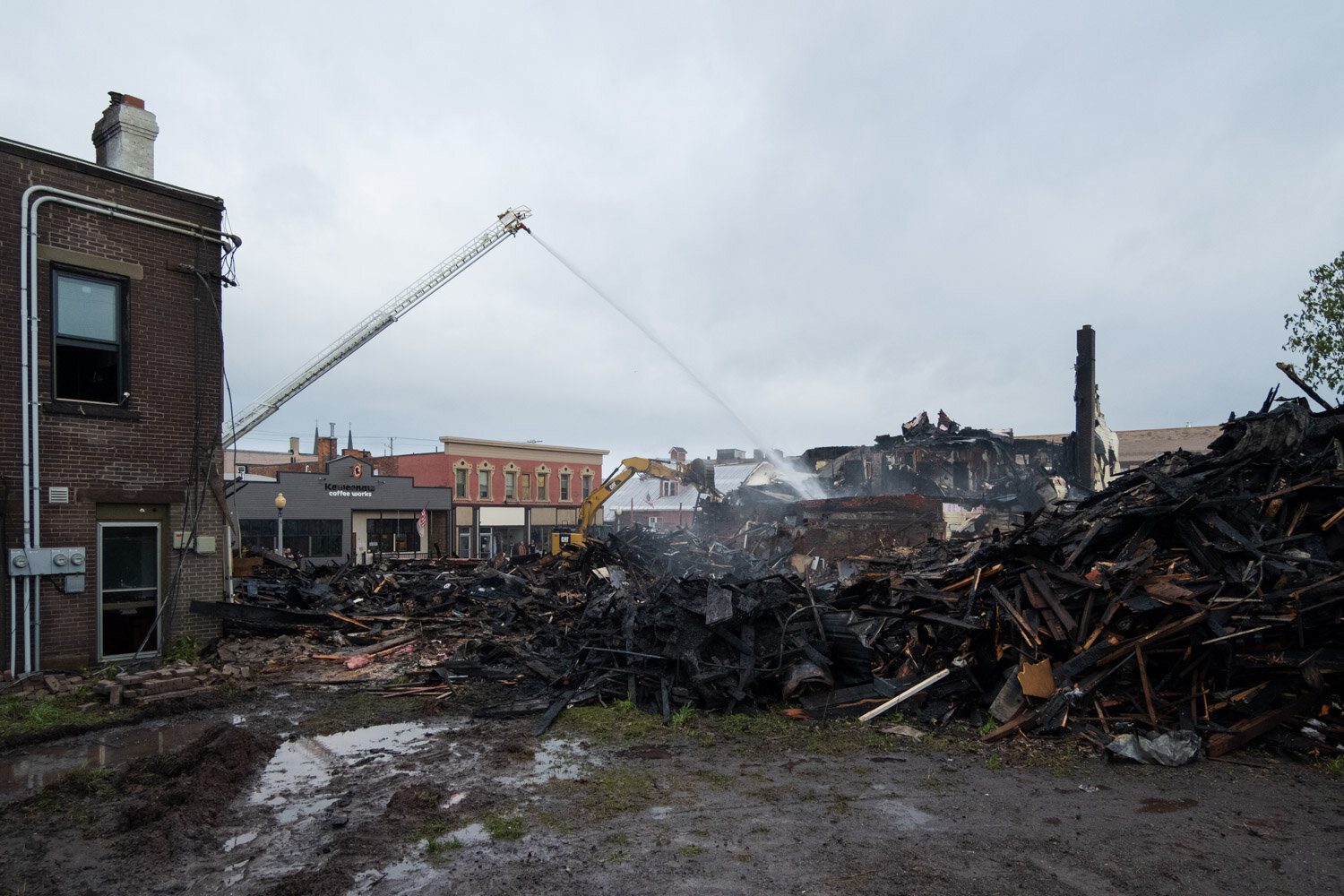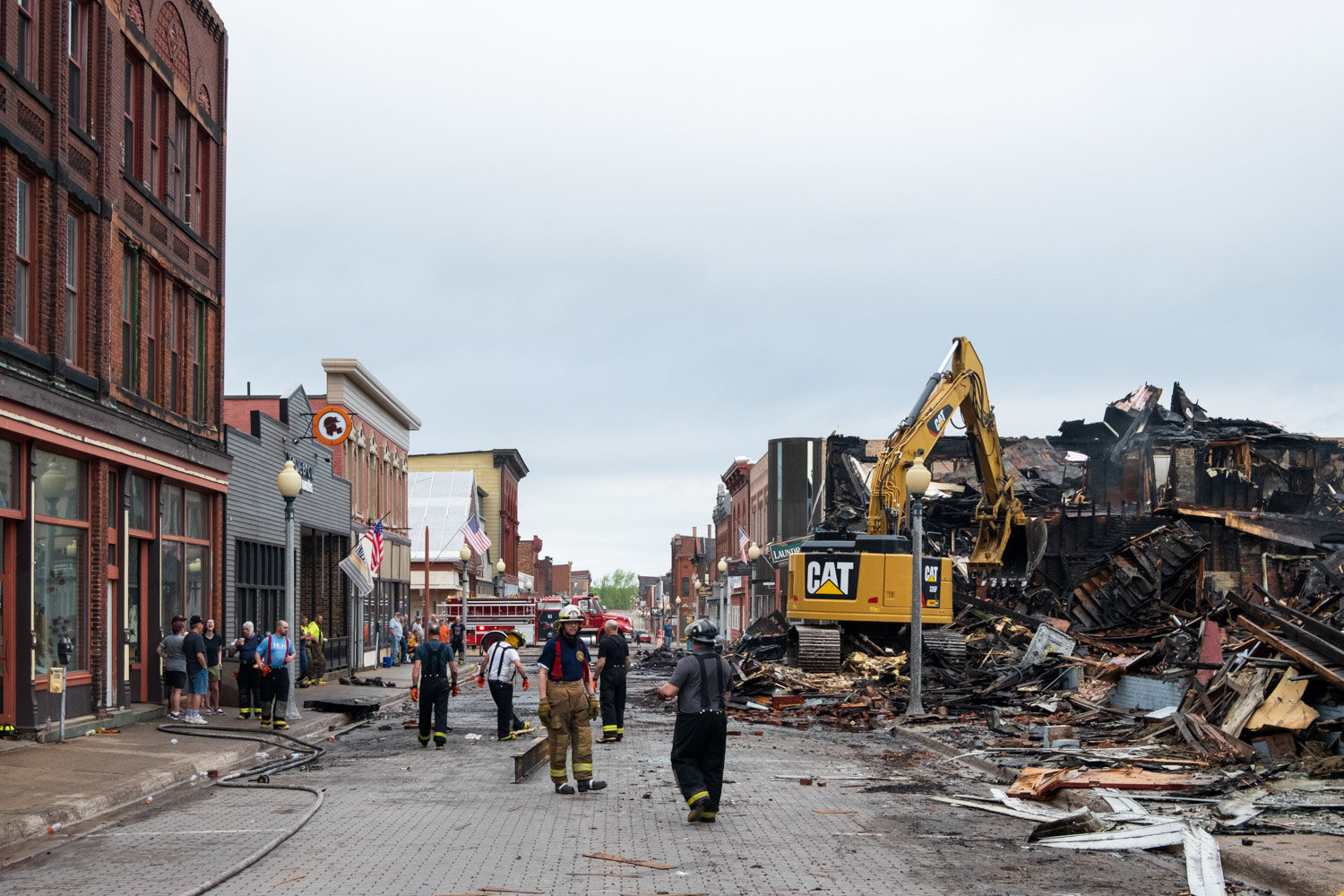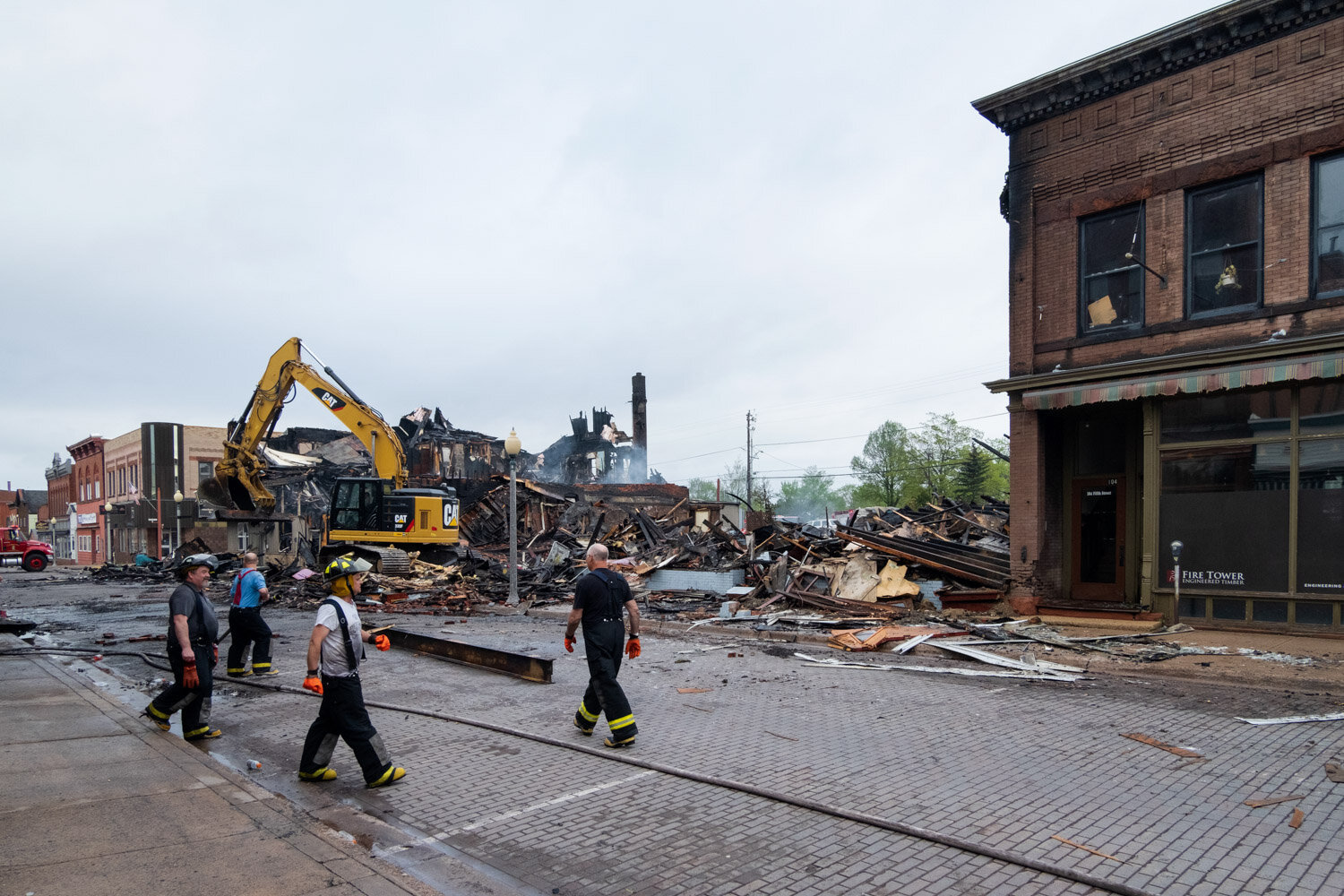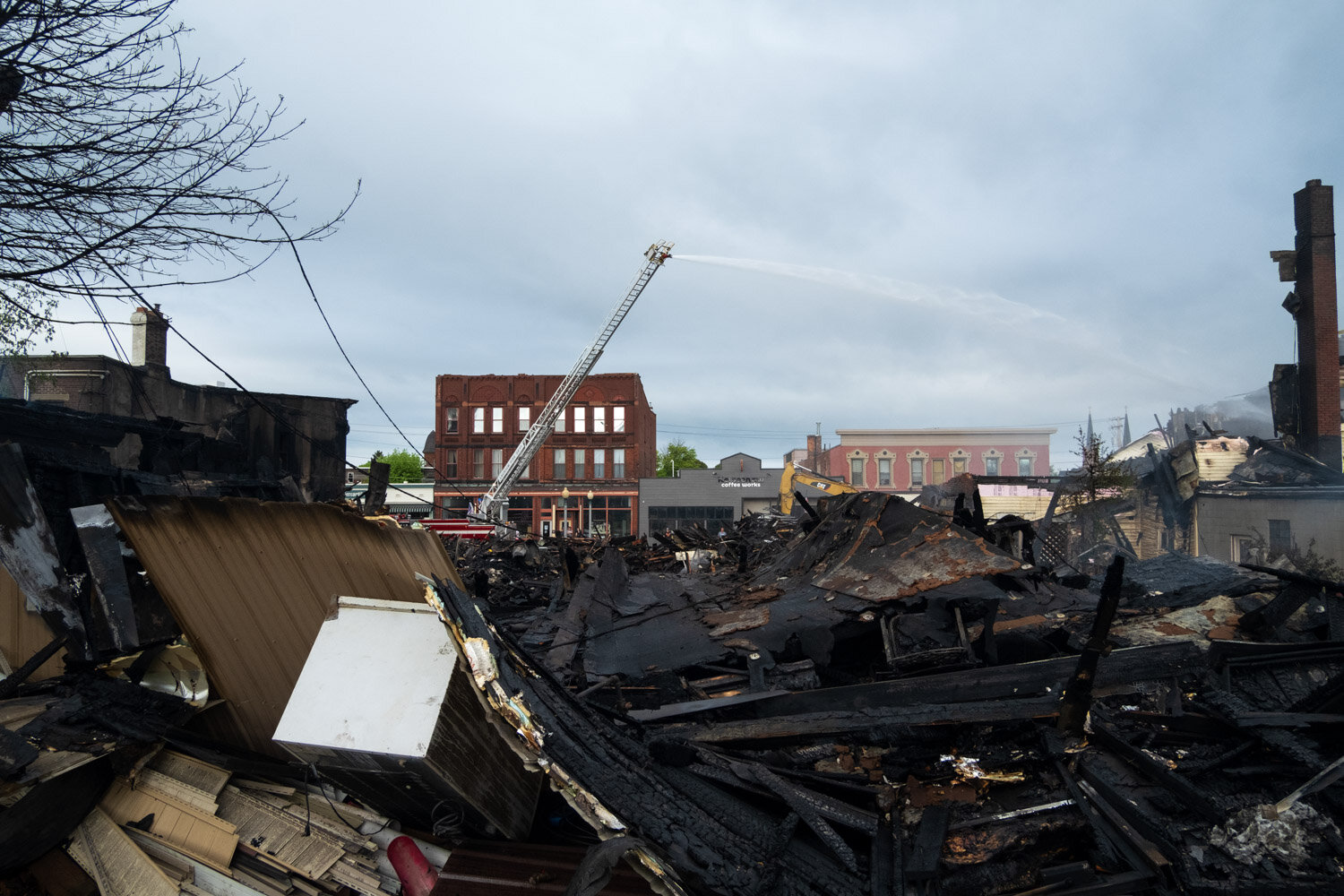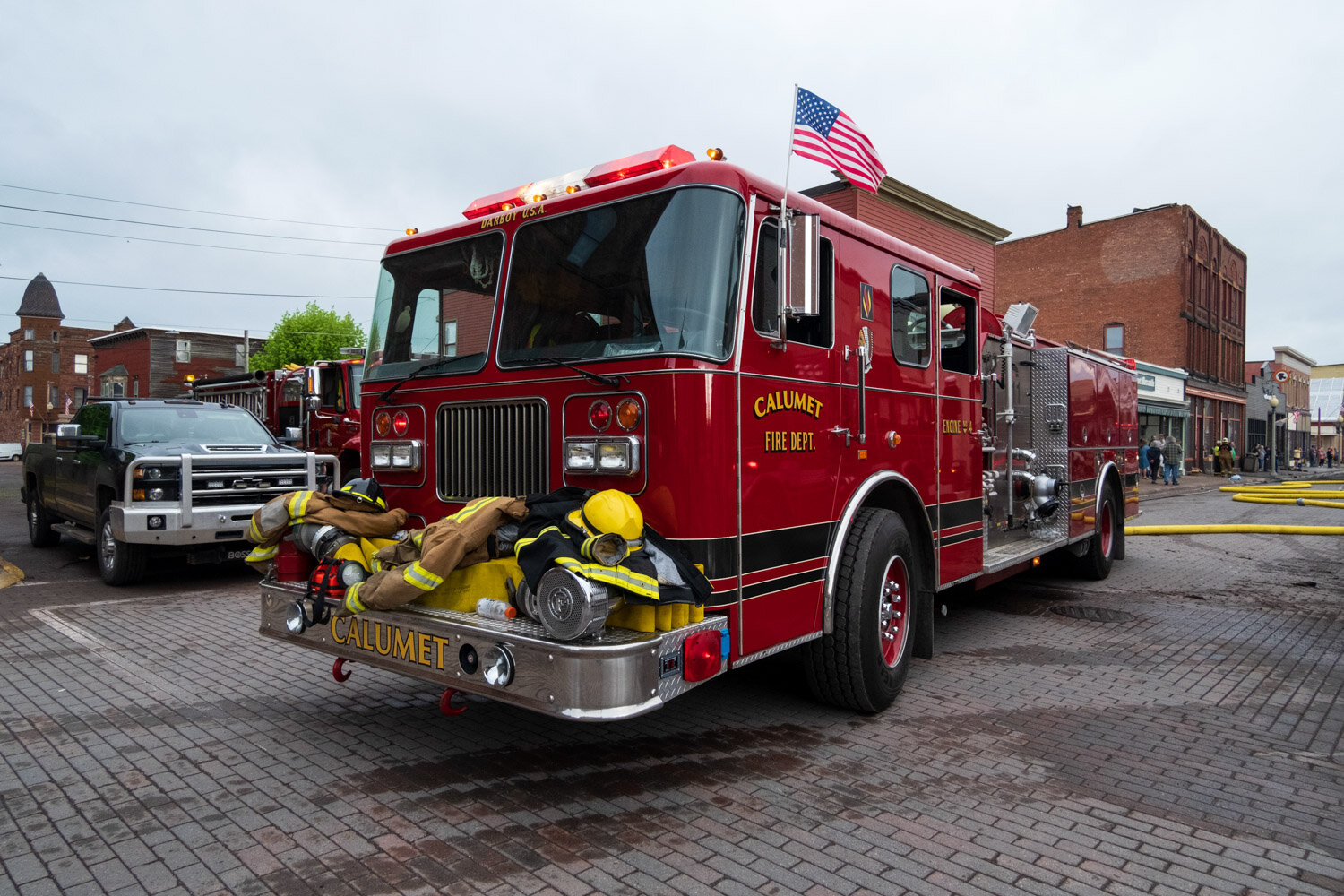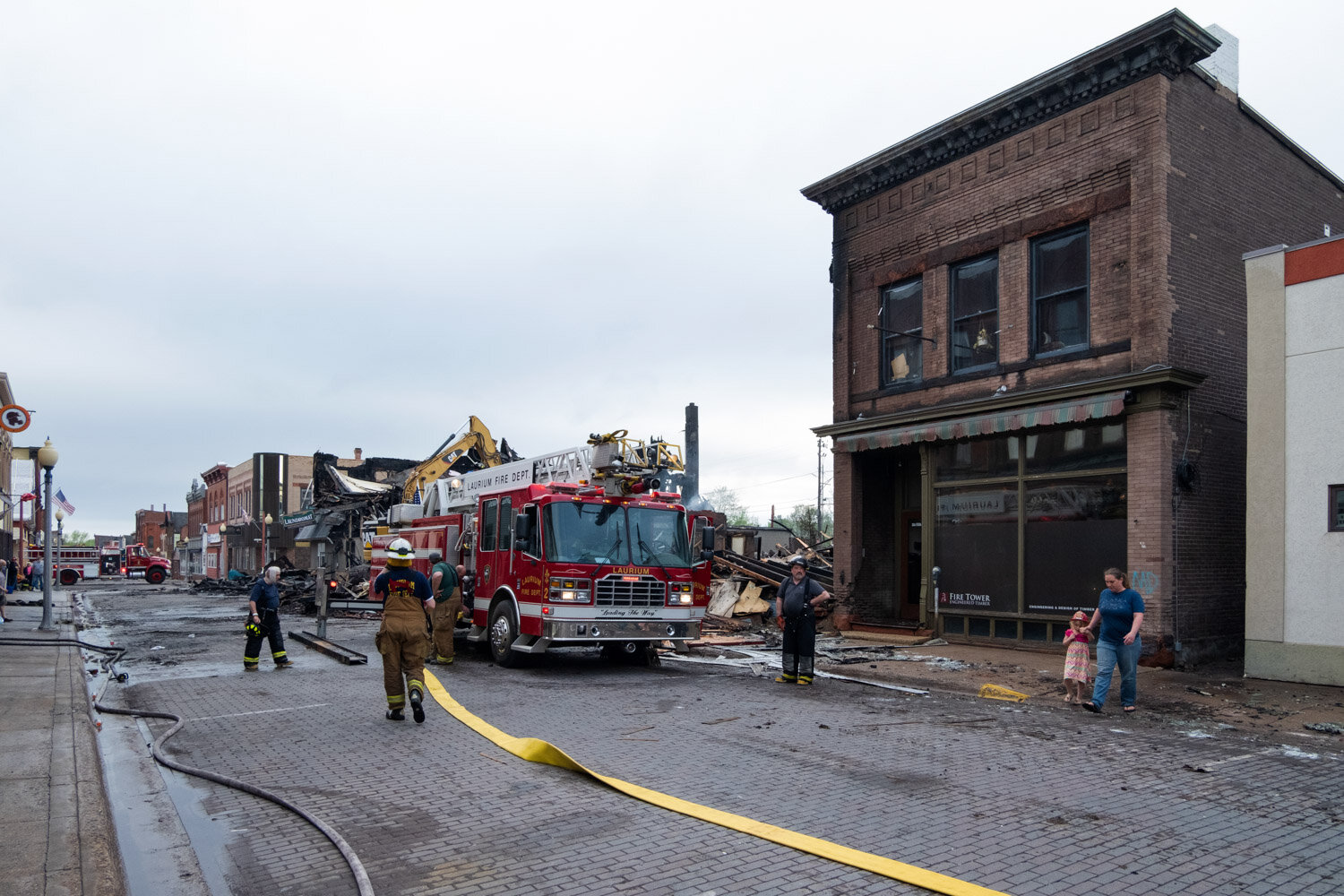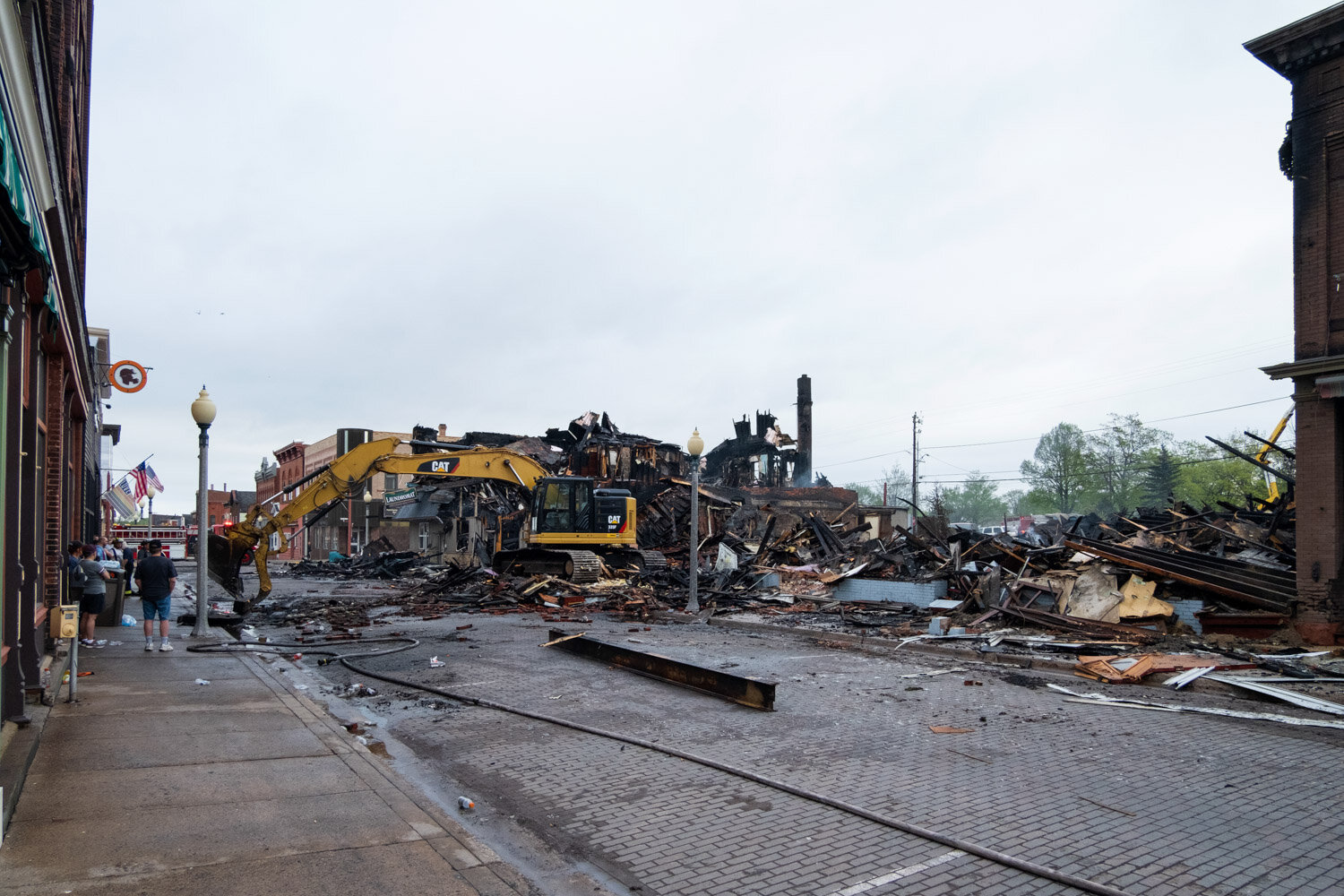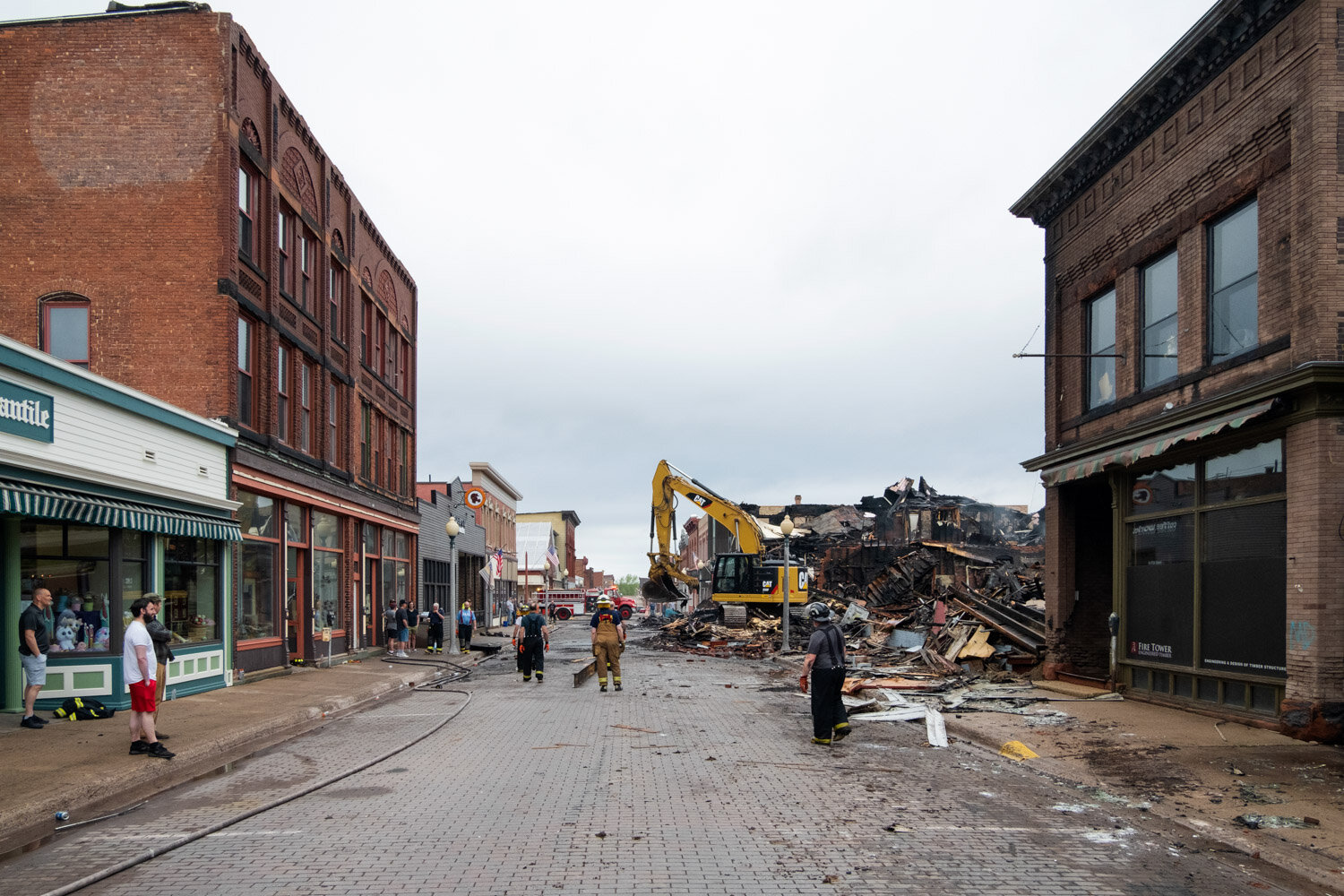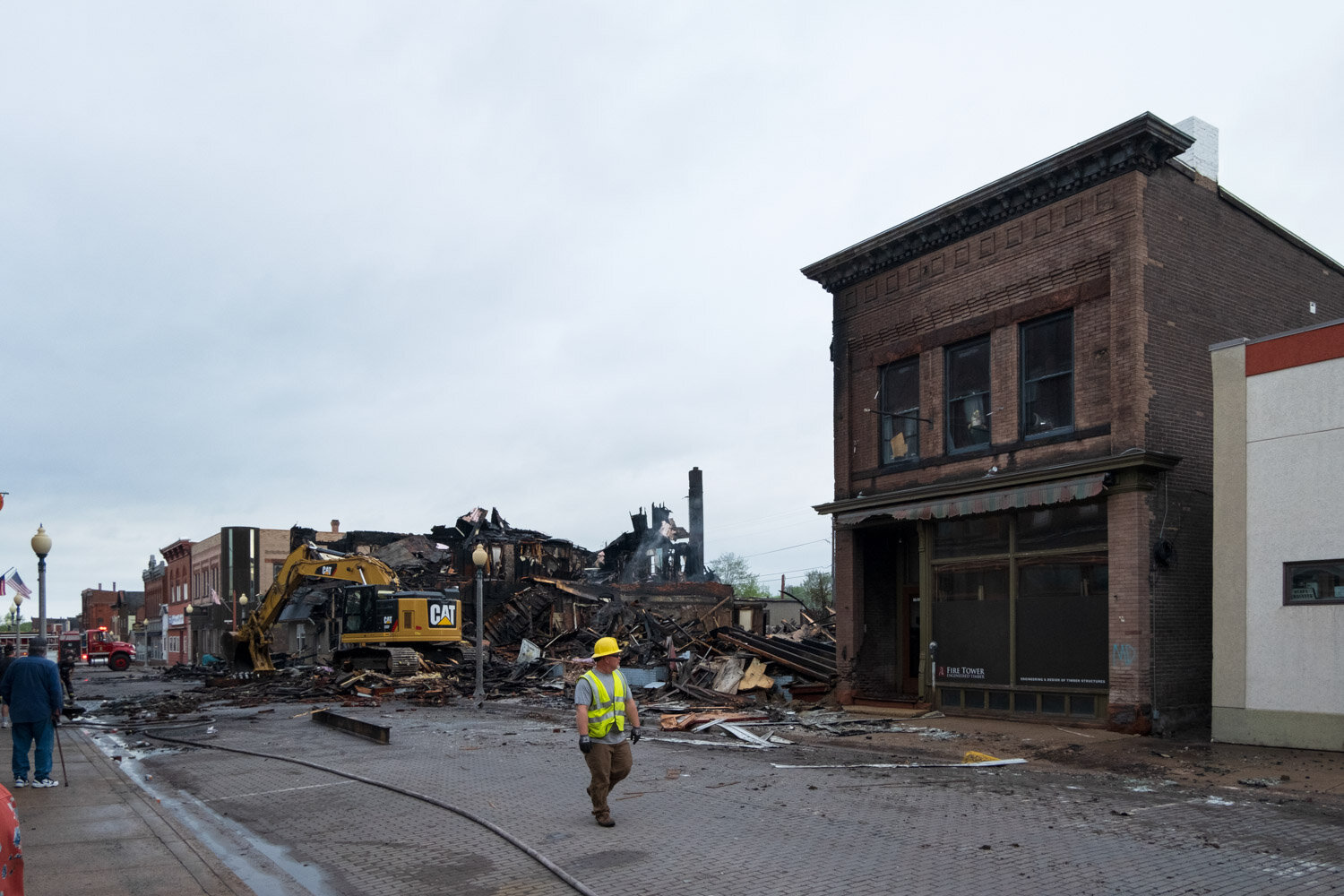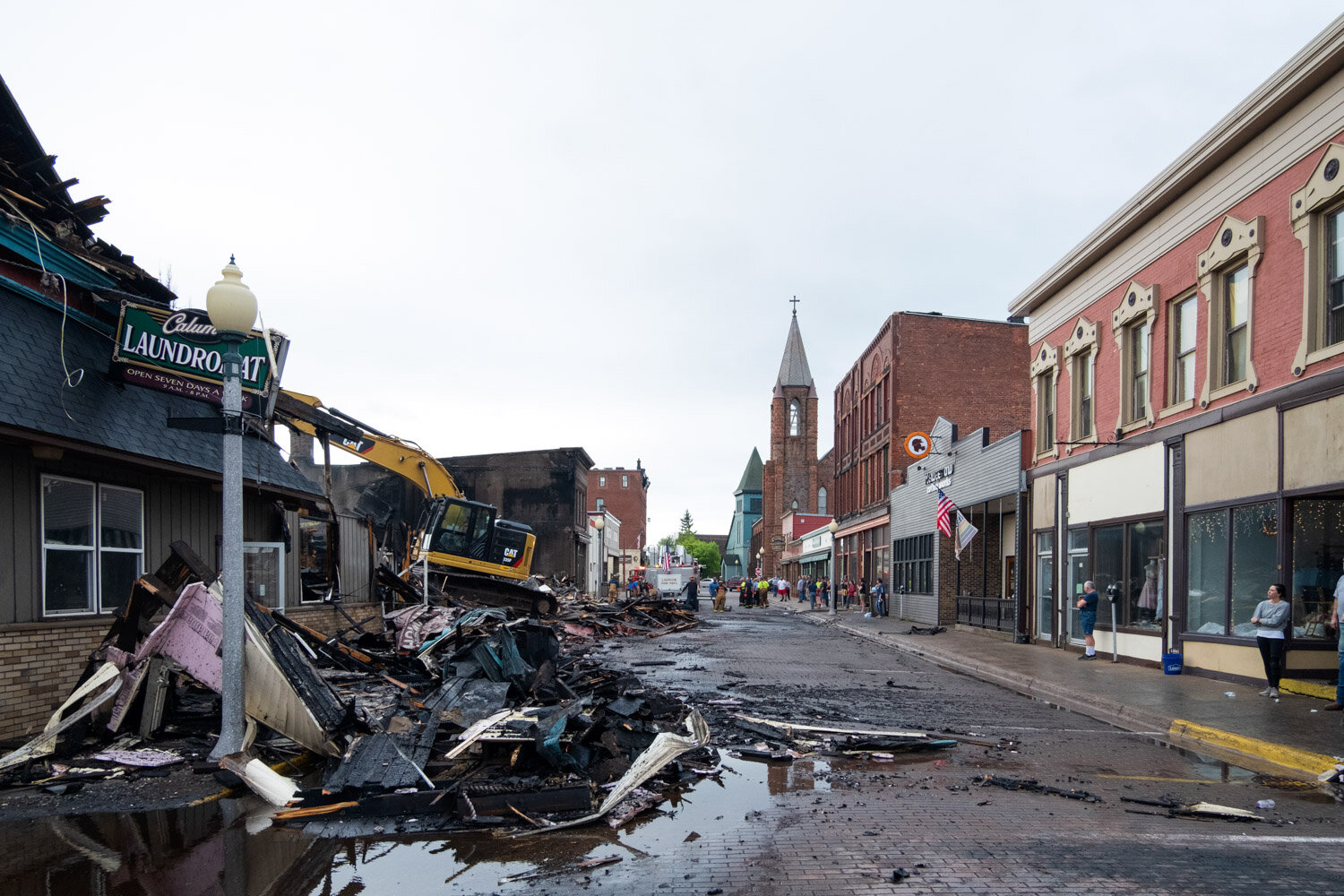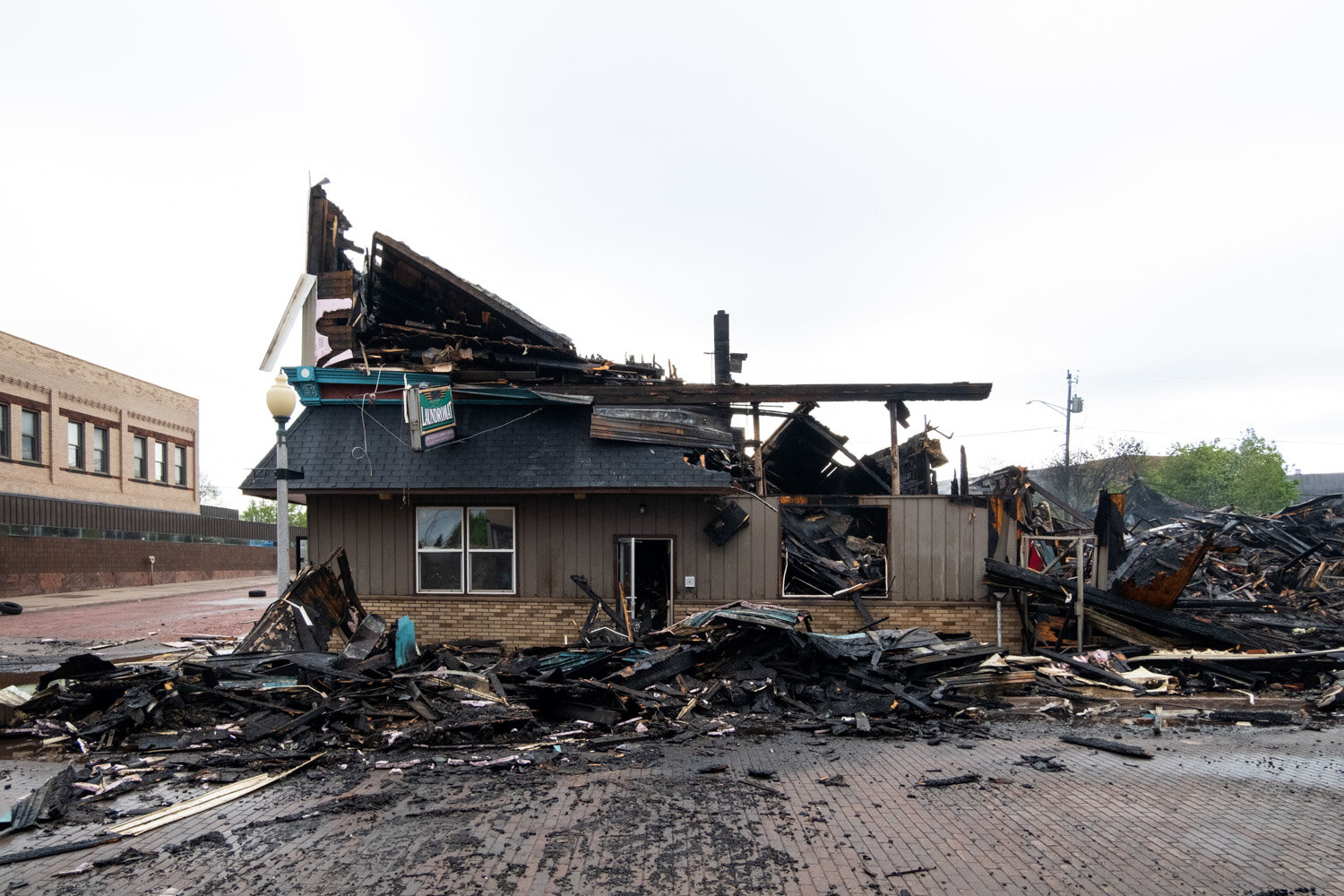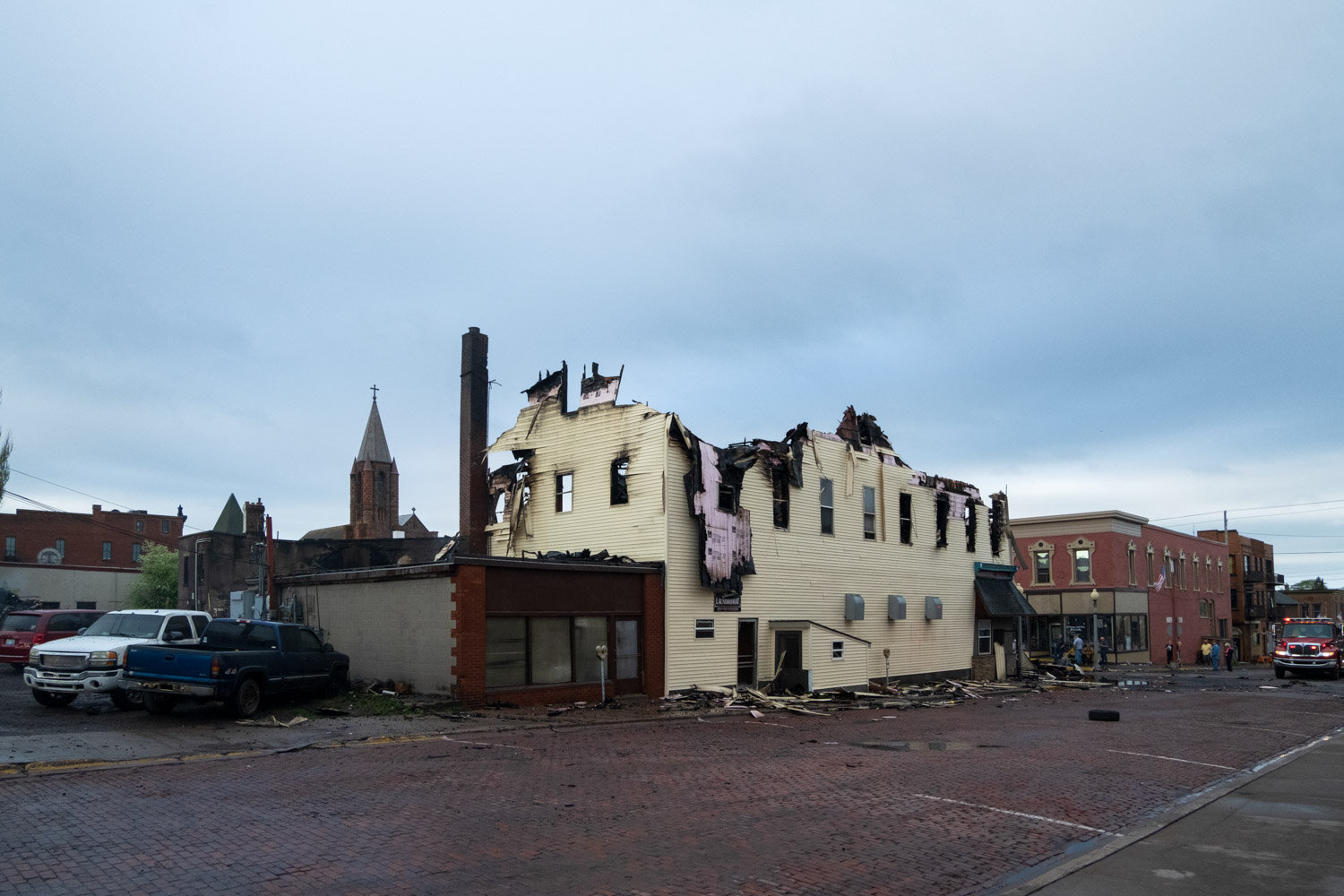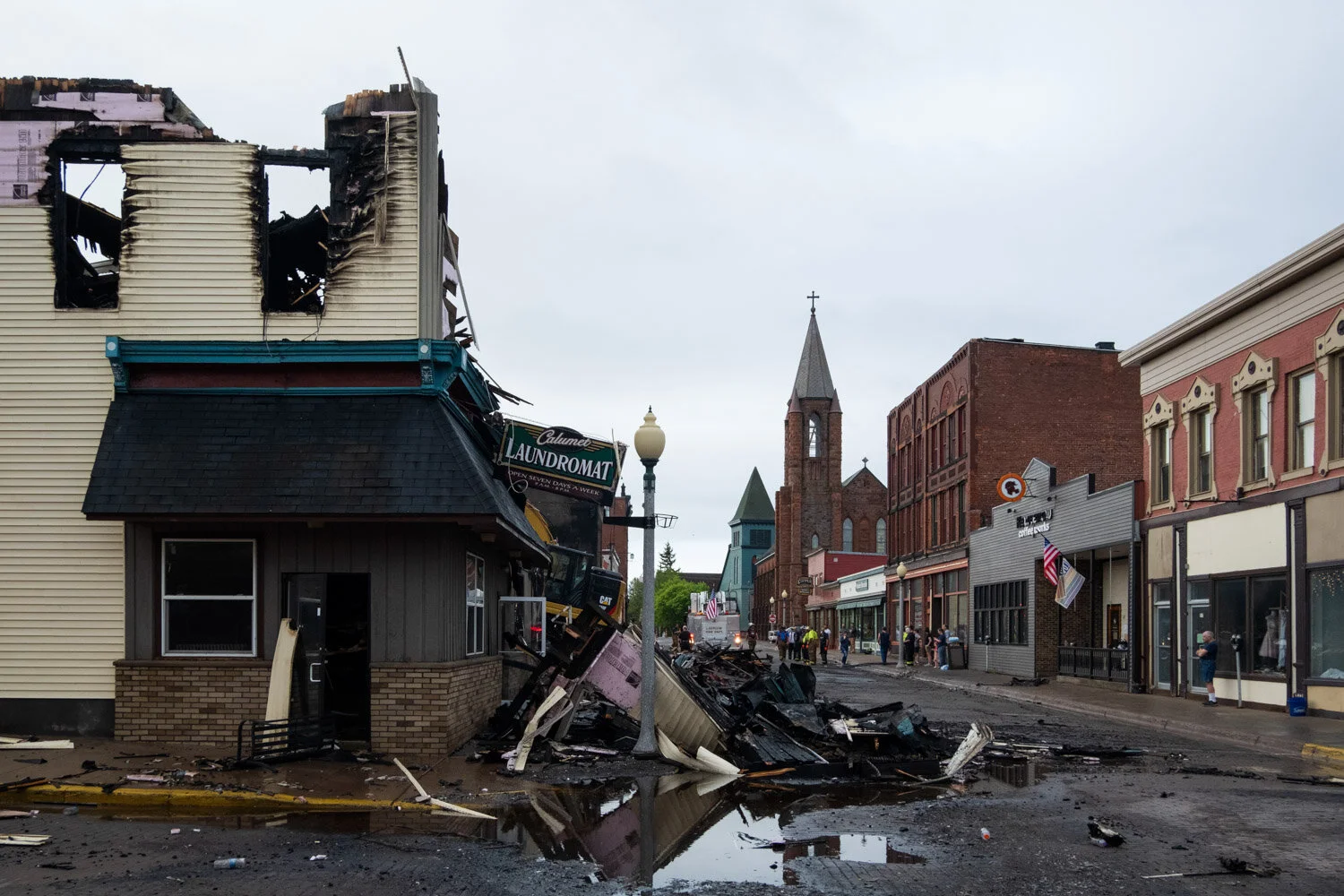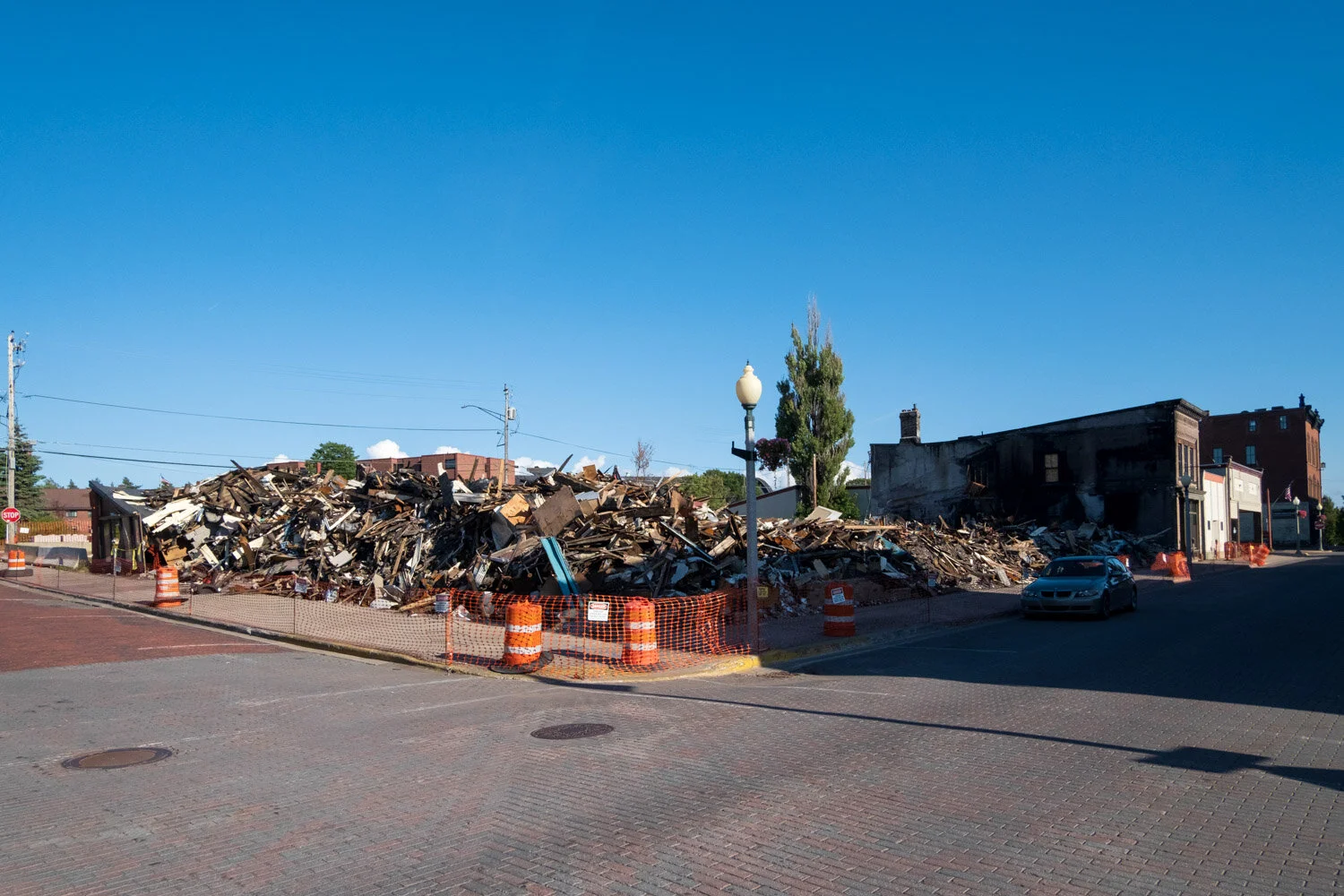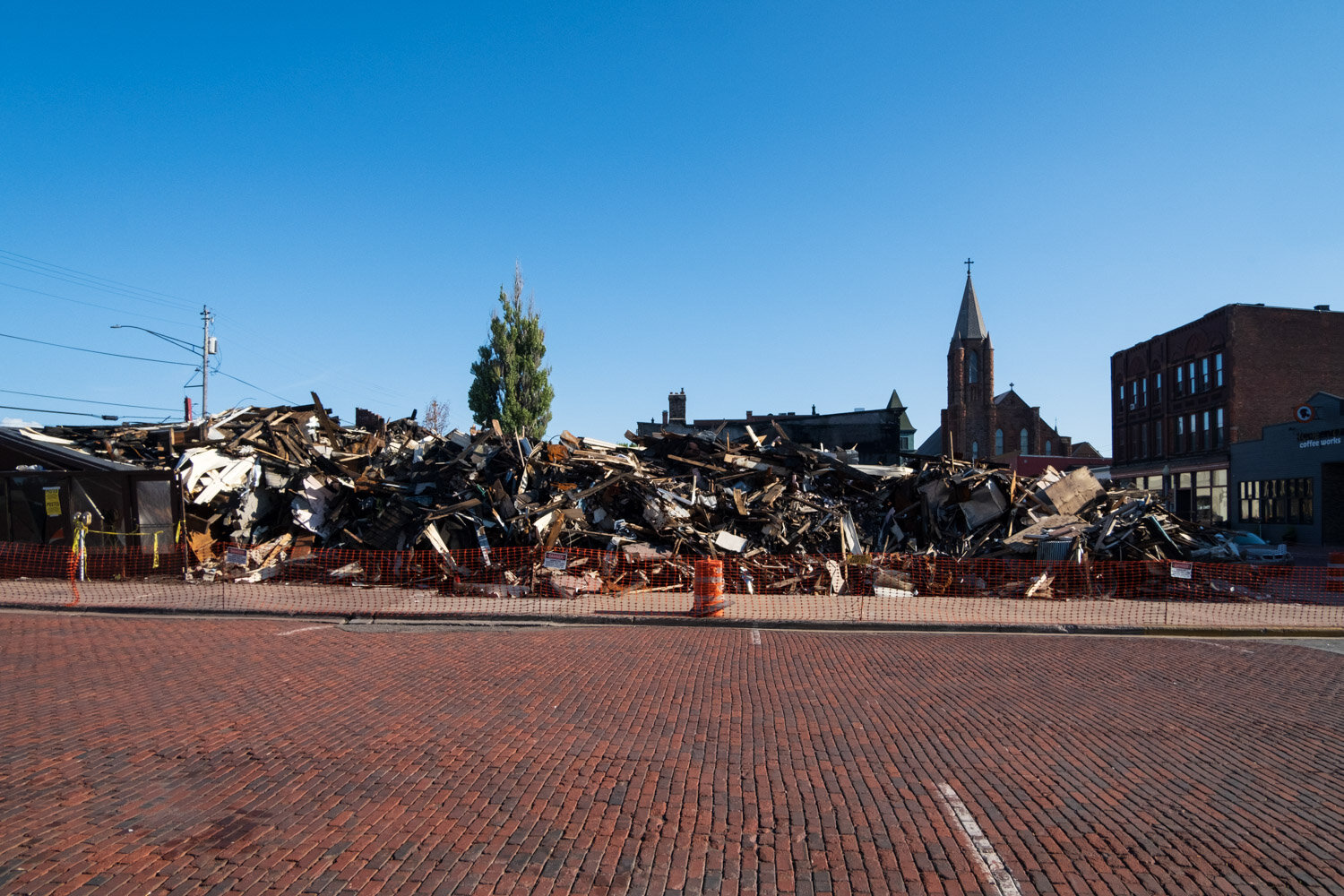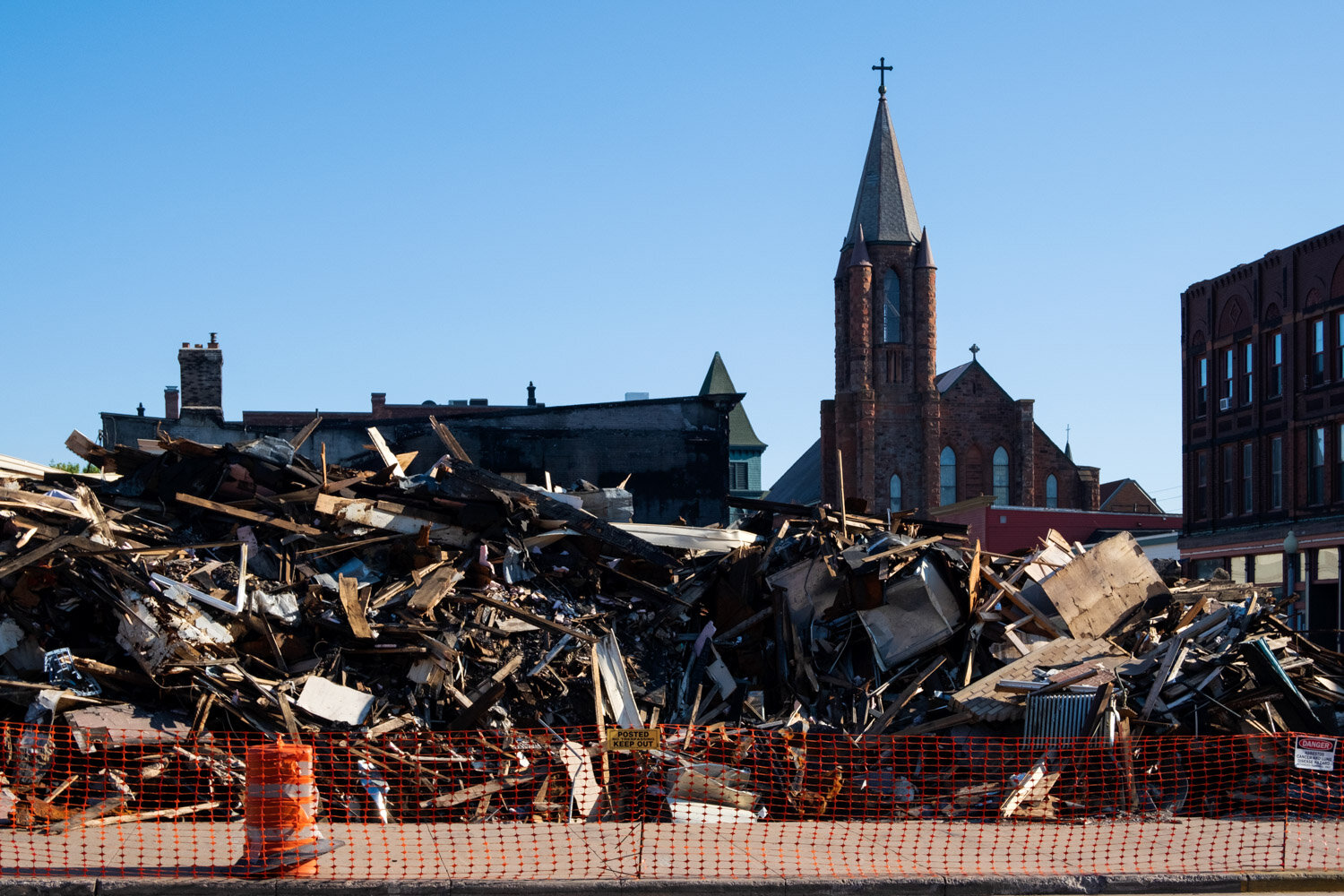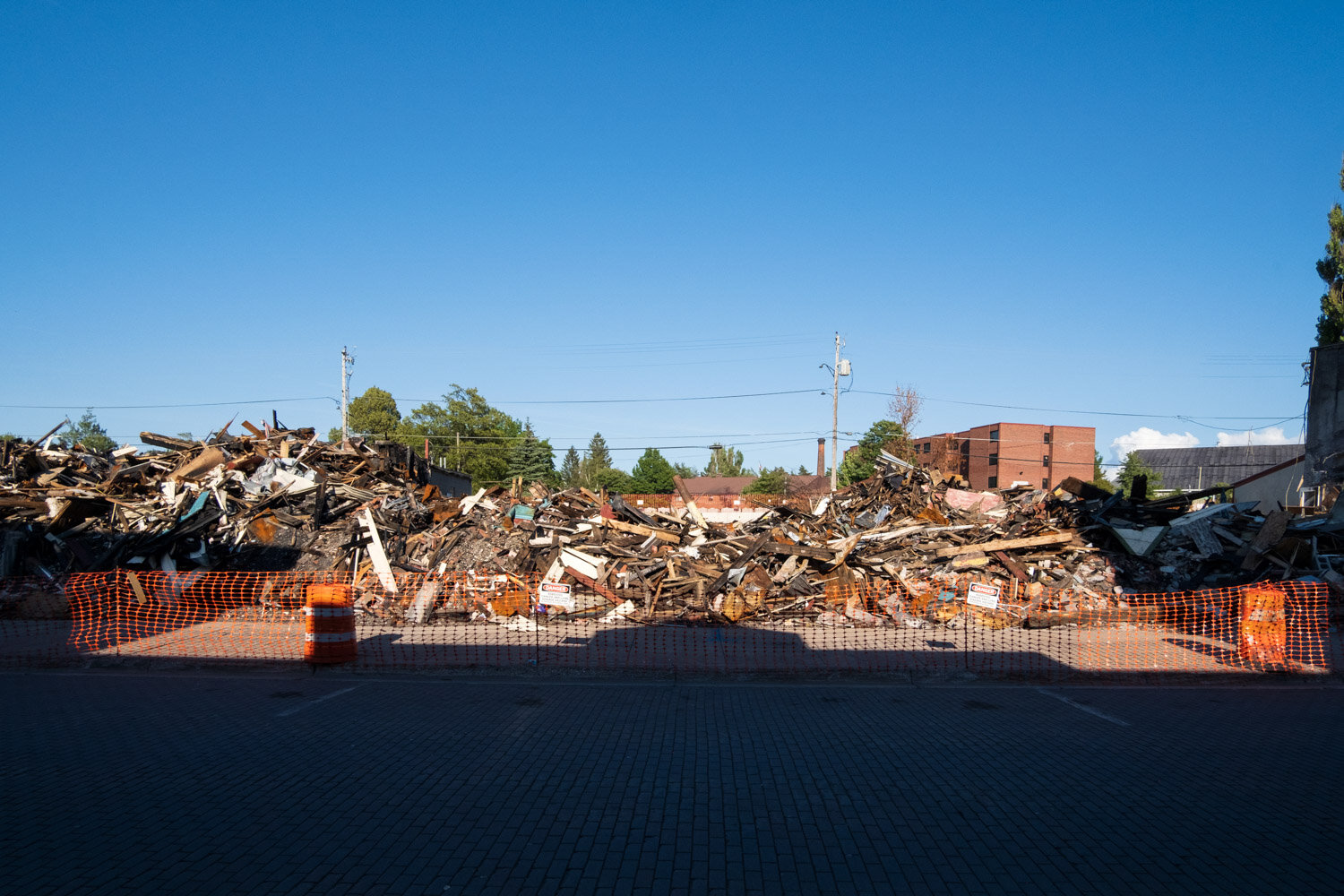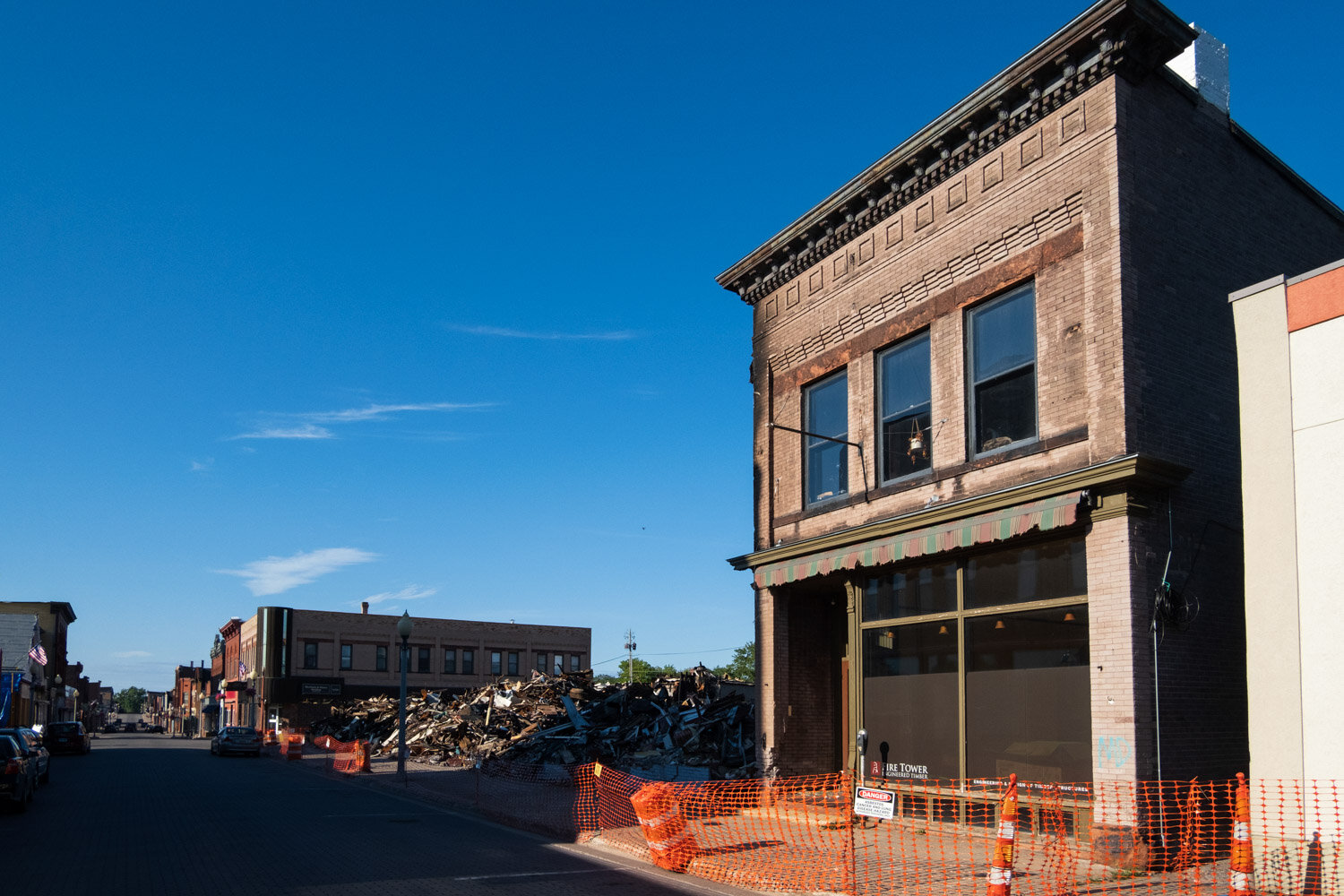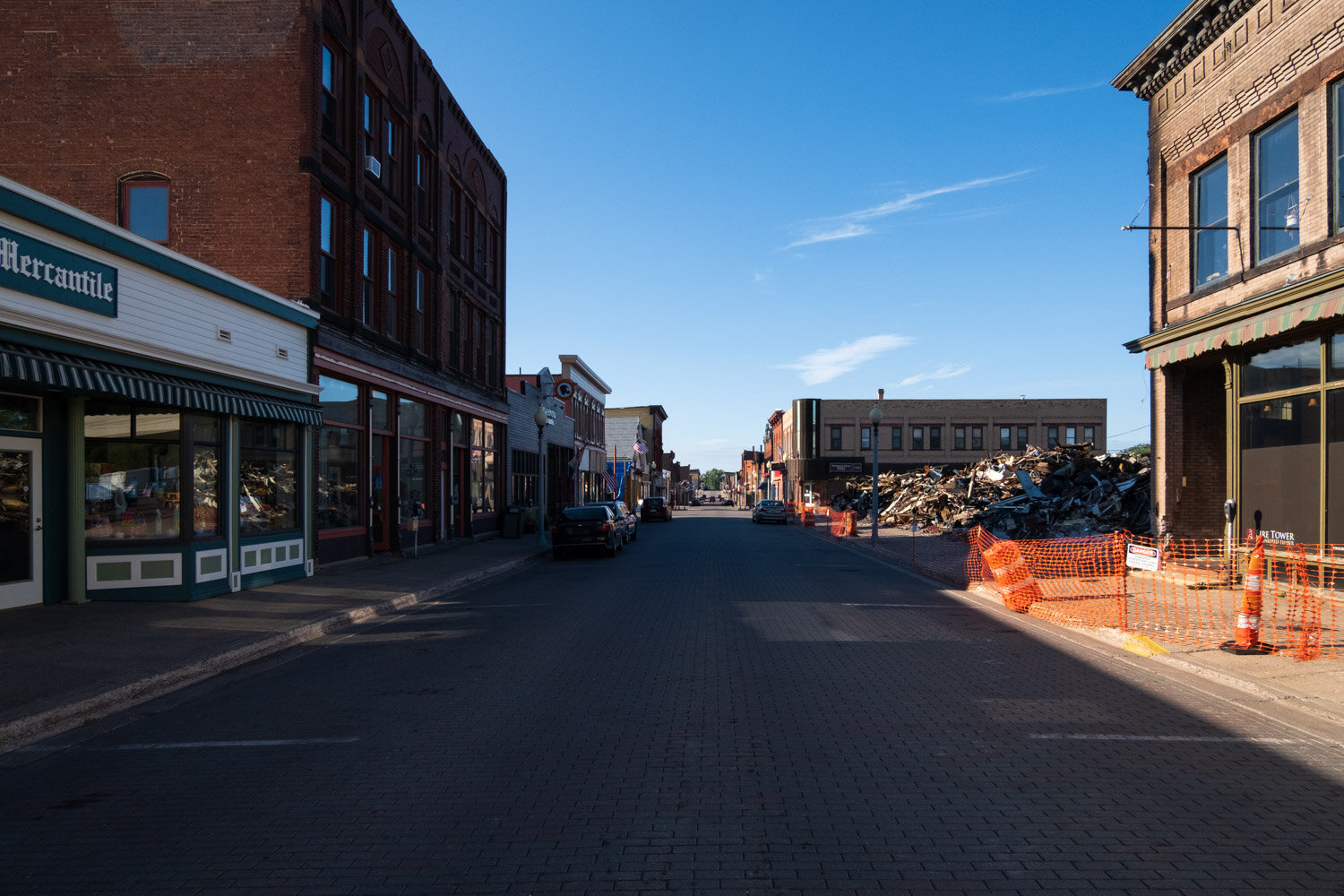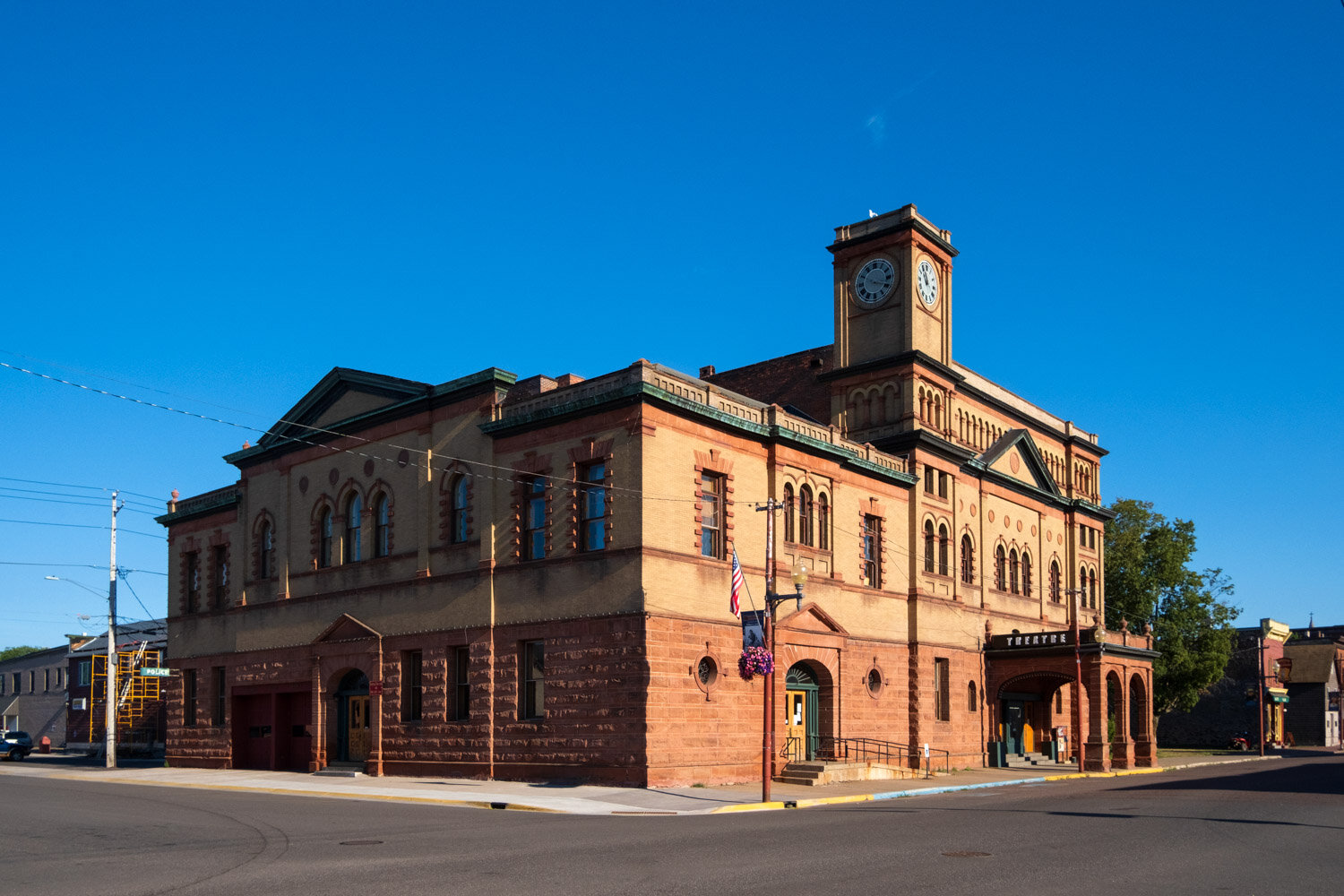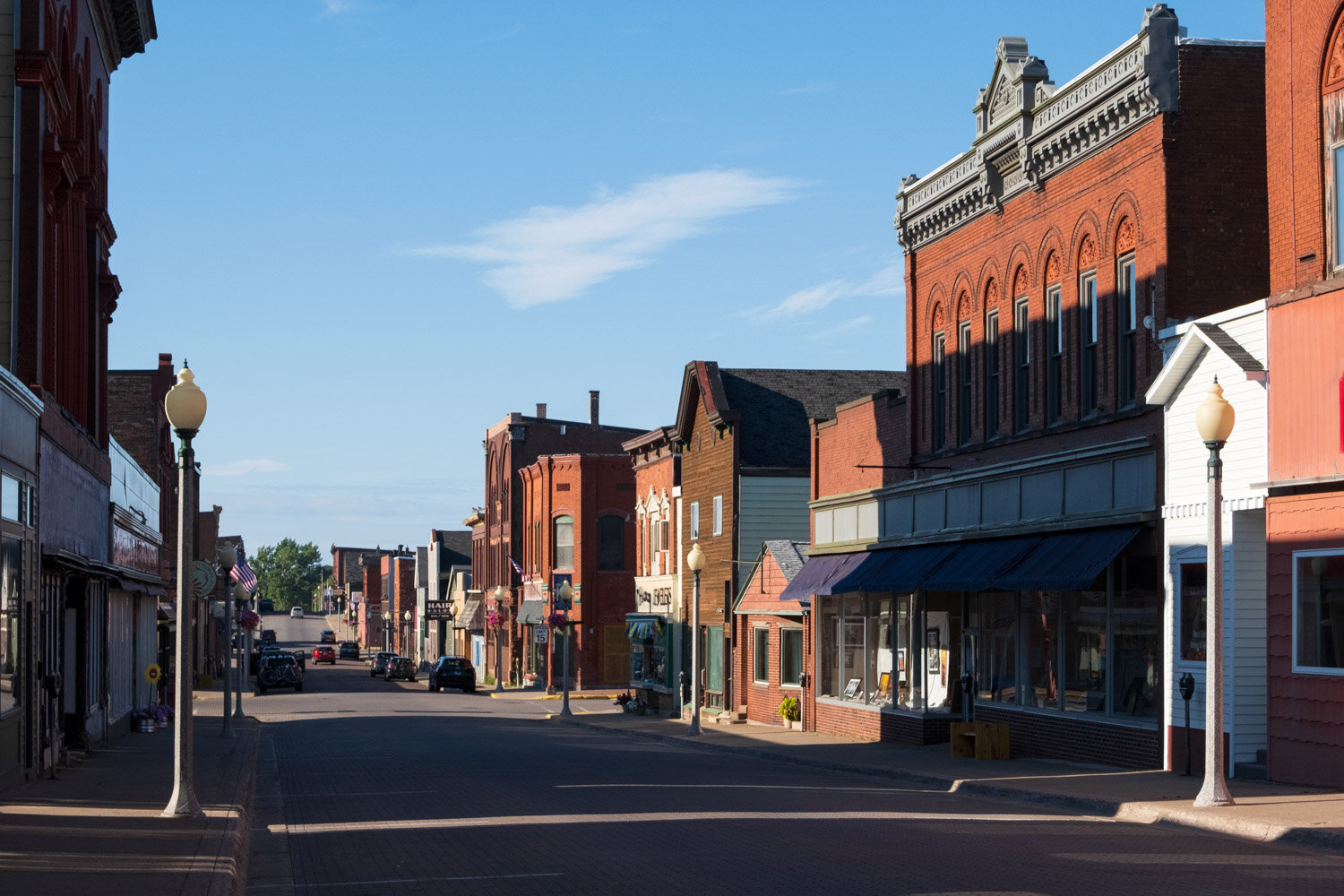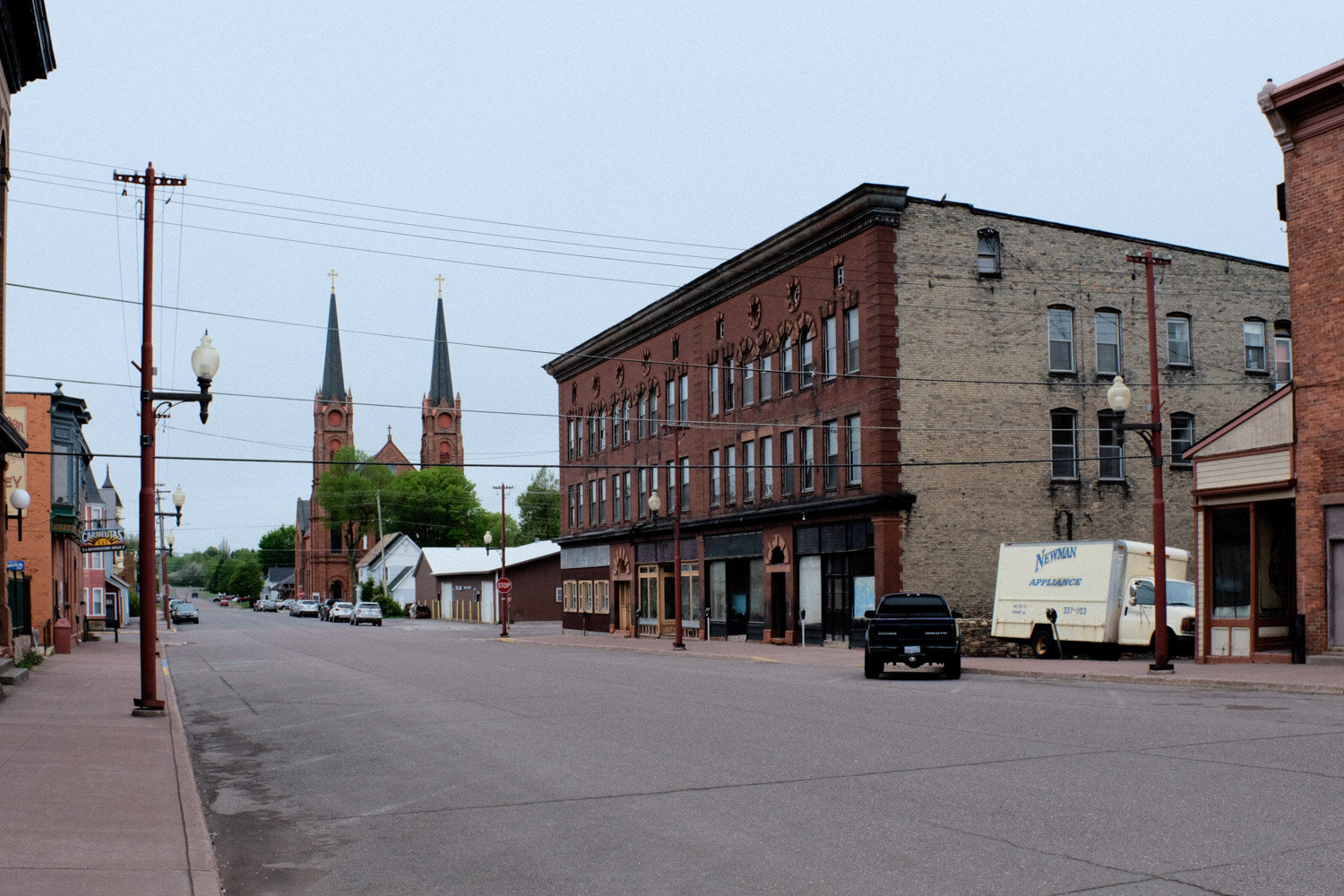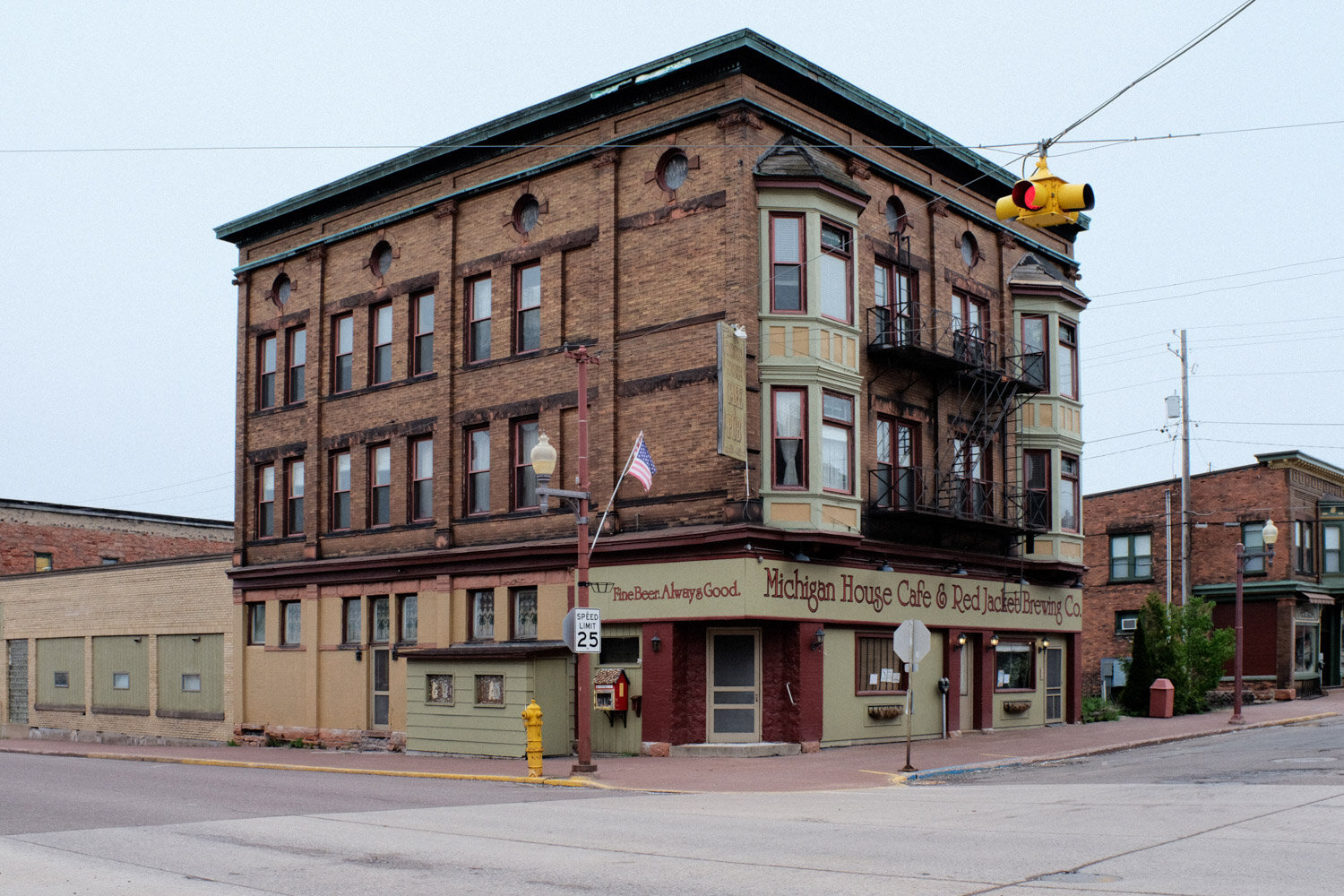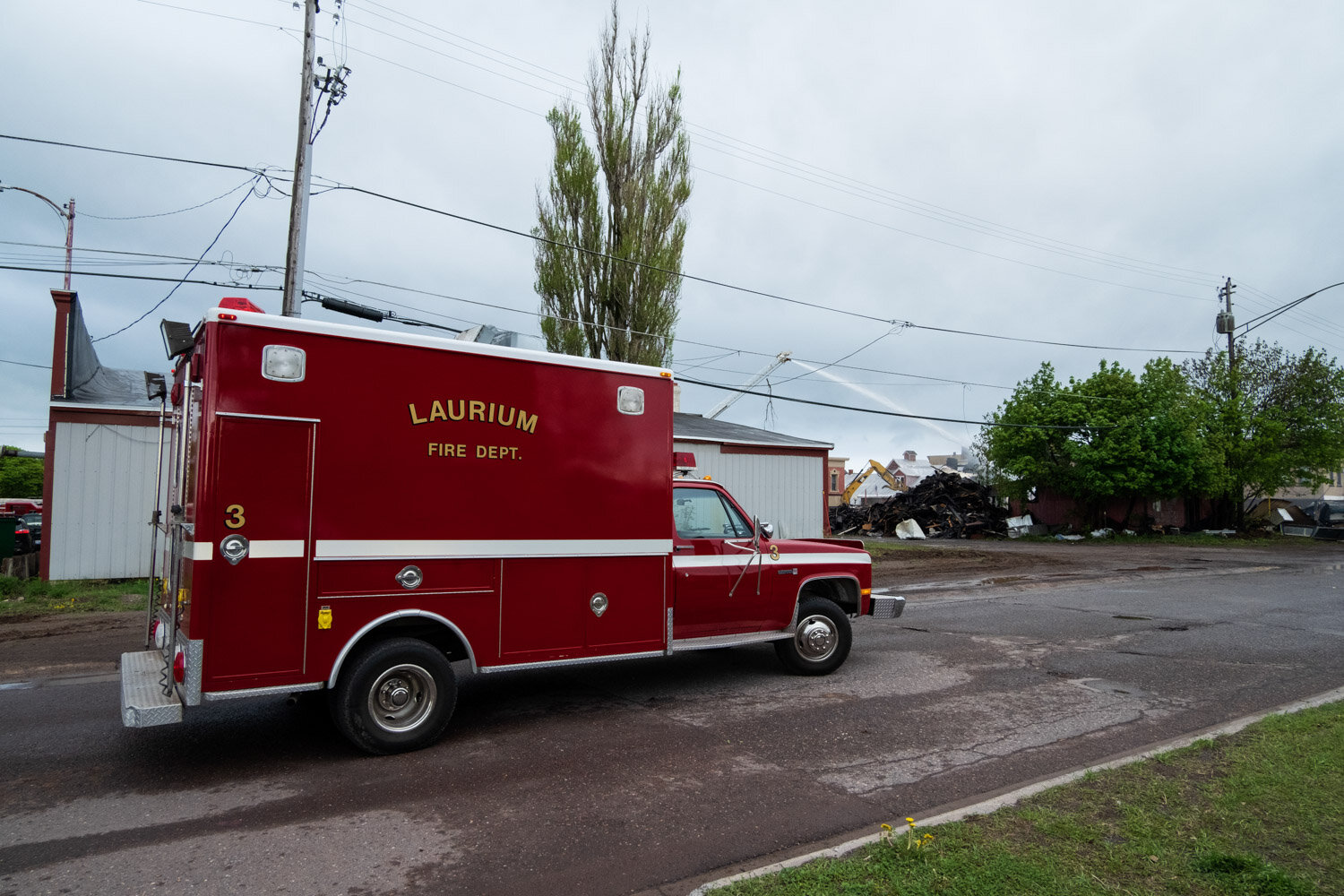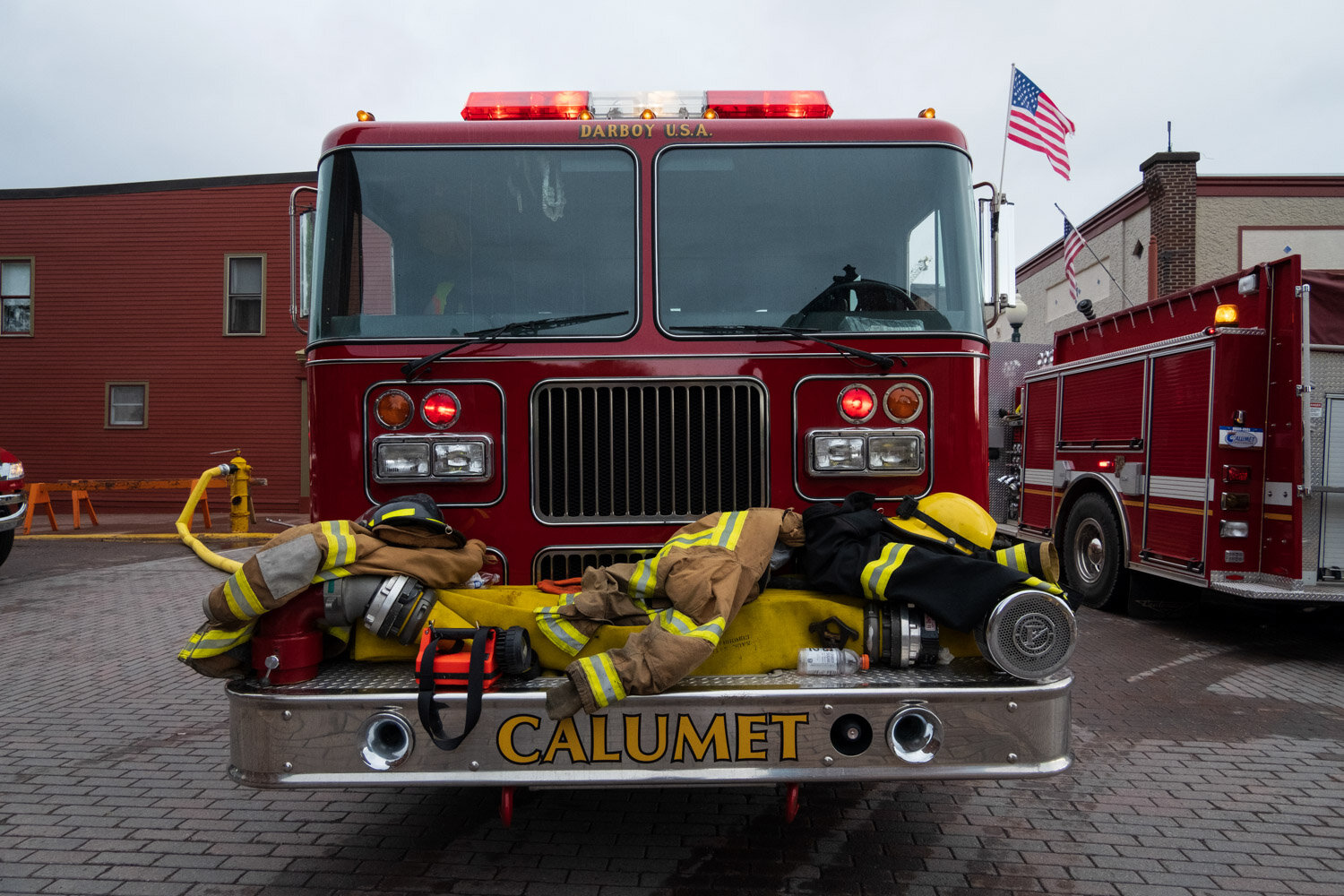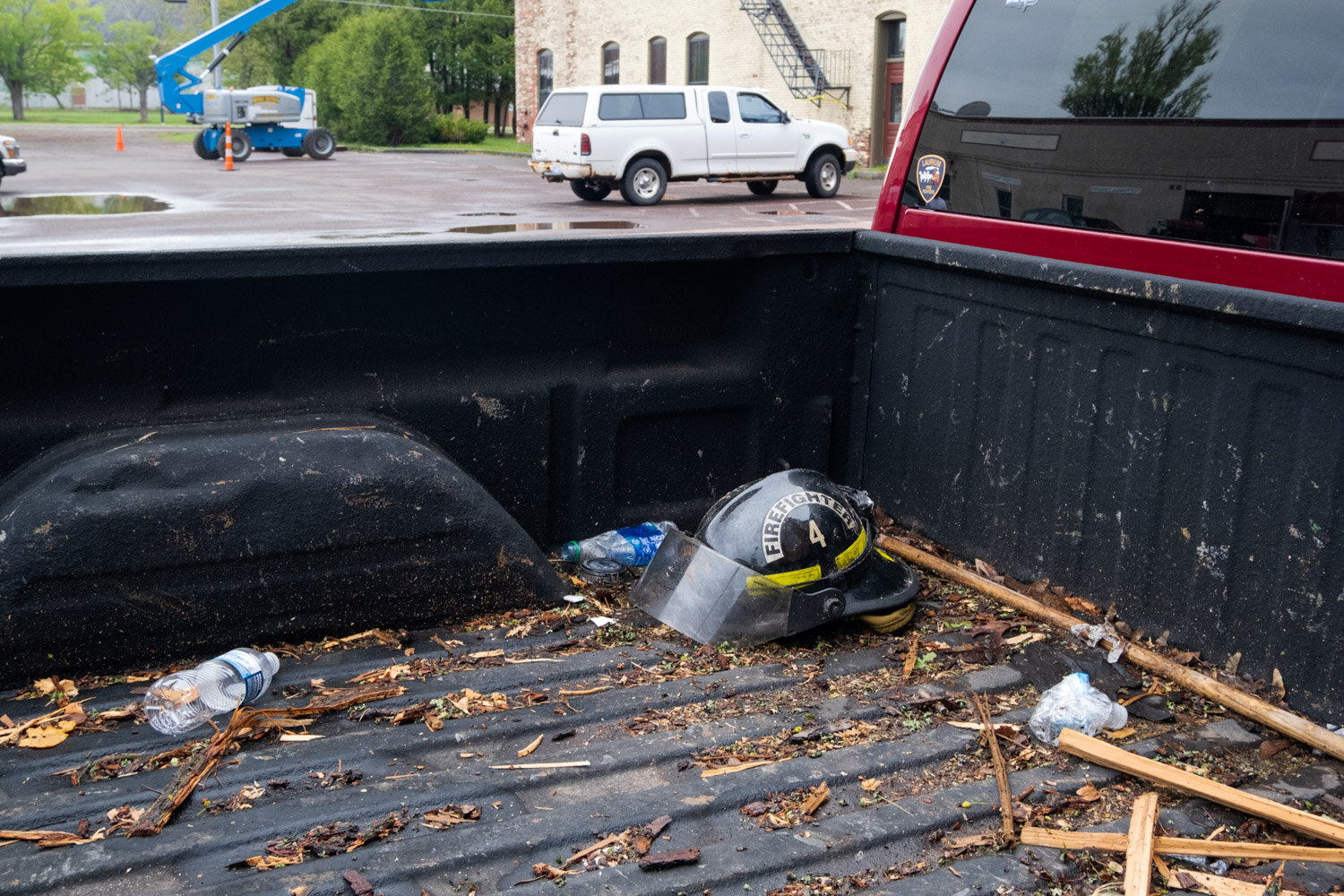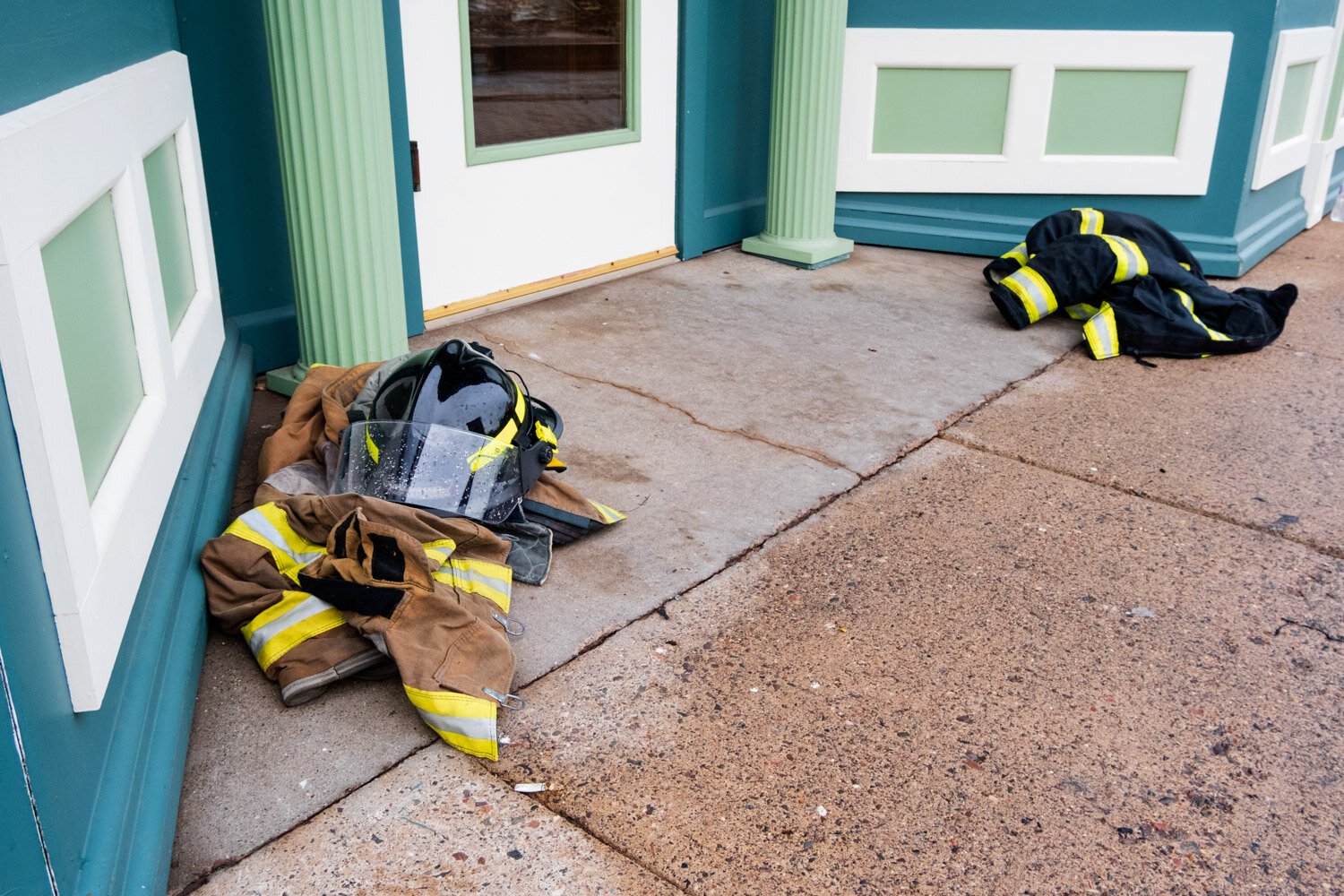The Calumet Fire of 2021
In the evening hours of May 21st, 2021 the Calumet Village Fire Department received a call about a fire on the 100 block of 5th Street which would quickly turn into a blaze that would consume three-fourths of the historic block.
The fire started at 108 5th Street, quickly spread to 112 5th Street, and eventually claimed 120 5th Street as well. 104 5th Street, just on the other side of the building that was first to ignite, was badly damaged, but still stood when things were said and done. 108, 112, and 120 5th street were not so fortunate, having been reduced to all but a pile of rubble by the morning of May 22nd.
The smoldering remains of 5th Street on May 22, the morning after the fire
At the time of the fire 108 5th Street was listed as owned by Reid Rastello and Julie Johnson, 112 and 120 5th Street were listed as owned by Josephine Brey, and 104 5th Street was listed as owned by Sand Bay Holdings.
As the fire raged, the Village of Calumet Fire Department soon realized they would need more help. The entire Calumet Village Fire Department consists of volunteers and was ill equipped to handle a fire of this size, so they called in for backup. There are small, mostly volunteer, fire departments dotting the landscape of northern Houghton County and further north into Keweenaw County, most of which sent firefighters and resources. Help also would come from the Houghton Fire Department, by far the largest force in the area. In total, 12 different fire departments fought the fire. Three firefighters from the Calumet Department suffered minor injuries and were able to walk out of the hospital on their own accord later that day.
After hours of work, firefighters began to show signs of fatigue
So much water was used to fight the blaze that the system was nearly run dry, potentially allowing for bacteria and other microorganisms to take hold at high levels within the system. This caused Michigan American Water to put a boil water advisory in effect until the system could be balanced again. The advisory would be lifted on the 24th.
The cause of the fire was not immediately known, and today is still under investigation. All three of the buildings that were destroyed dated back to Calumet’s prosperous history as a mining-mecca and many had not been updated in decades. There are a million things that could have caused the fire, and a million more things that could have caused it to spread as rapidly as it did. Although two of the three building’s had commercial spaces that were not being fully utilized at the time of the fire, at least two had apartments on the upper floors that were leased. The commercial space that was in use was a laundromat.
The remnants of the laundromat on May 22, the morning after
TV-6 reported that 41 people had to be relocated due to the fire, a staggering 5.5% of Calumet’s estimated population of 744. Local non-profits assisted those displaced with replacing what was lost and helping them to find new housing accommodations. Luckily, other than the three injured firefighters, no one was harmed in the blaze.
With residents finding new homes and rebuilding, officials from the village were tasked with what to do about the three properties that were utterly destroyed by the fire. The presence of asbestos and lead paint made the prospective clean-up efforts daunting, and expensive, so Interim Village Manager Dave Geisler phoned the Environmental Protection Agency for help.
The rubble remained on August 1, over 70 days after the fire
Although the agency agreed to help, progress was extremely slow. The rubble sat for months until concrete dividers, like those seen on the highway during construction, were stacked around the debris like a levy. The smell of ash still lingers on the block, even as the EPA has finally begun to clean up the properties. There is not currently a plan for the future of the property, but no matter what the plan may be, a gaping hole now presides over what once was Calumet’s main drag. Many will not be able to fill that hole with anything but the memories of the fire and the significant loss it represents, but many hope for a positive future and have an eagerness to rebuild.
This was not the first time that a fire tore apart Calumet, or at least the idea of a fire. On Christmas Eve in 1913 striking miners and their families were attending a holiday extravaganza hosted by the Western Federation of Miners when someone began shouting that there was a fire. There was no fire, but the alarm caused a rush for the door and a bottleneck occurred, causing the death of 73 people, a majority of which were children.
Calumet has retained many turn of the century buildings
Although the mining industry in the area had already peaked and was in a decline, this was the end of many families' time in Calumet. After the loss of a child, mother, or father, dozens of families uprooted and moved to manufacturing cities like Flint, Detroit, or Chicago. Calumet’s population peaked at the 1900 census with 4,668 people. Comparatively, Houghton’s population was 3,359 in 1900 and Marquette’s was 10,058. By the 1920’s Calumet’s population would drop below 2,000, and in the 1980’s below 1,000.
Staggering population loss is often remarked in reference to cities like Detroit, which fell from 1,849,568 people at the 1950 census to 639,111 people at the 2021 census, representing just 34.55% population retention over 70 years. Starting at Calumet’s peak population of 4,668 people in 1900, over 70 years the village would only retain 21.57% of its population, falling to 1,007 people in 1970. Although the population numbers are just a fraction of a city of Detroit’s stature, population loss of such high volumes is hard no matter what size a community is.
Calumet, to put it simply, does not have a lot of resources. The township’s median household income in 2019 was $37,841, nearly $20,000 less than the state average. A staggering 18.4% of the township lives in poverty, compared to 13% at the state level. A plurality of Calumet residents work in accommodation and food services, with another large percentage working in healthcare and retail trade. To say that the odds of big investment in Calumet is low would be an overstatement.
Citizens and visitors in Calumet watch crews tear through the ashy remains
Even with all of those statistics looming overhead, the people of Calumet are resilient and kind to their neighbors. The fire was still raging when community residents began collecting money and items for those who would subsequently lose their homes. Local non-profits would quickly apply for grants to aid them as well, receiving help from across the country. Almost all of the firefighters who worked for hours into the night to protect the rest of the historic city of Calumet were unpaid volunteers. The coffee joint across the street from the blaze put out free coffee and pastries for the firefighters and anyone else who was helping in the effort to keep the town safe.
Calumet is one of the most unique and interesting places I have ever been, and the people that call the town home are truly a different breed. In a day and age where everyone seems to be moving further and further apart on every imaginable talking point, citizens of Calumet have found a way to come together and support one another, and I admire the hell out of that. While photographing the scene the morning after the fire it was very easy to tell who was a tourist and who called the Keweenaw home. The loss of the three buildings on that fateful May evening are truly tragic, and only time will tell what will come from the cleanup efforts. But if anything is clear, Calumet will do it the Calumet way—together, and with everyone in mind.
Looking down 5th Street from Red Jacket Road the morning after the fire
A very special thank you to the tireless work of the firefighters from these departments, because without their work, the City of Calumet may look completely different today—Ahmeek Village Volunteer Fire Rescue, Bootjack Fire & Rescue, Calumet Township Fire and Rescue, Calumet Village Fire Department, Dollar Bay Volunteer Fire Department, Hancock Volunteer Fire Department, Houghton Fire Department, Hubbell Fire Department, Lake Linden Volunteer Fire Department, Laurium Fire Department, Quincy-Franklin-Hancock Township Fire Department, and Tamarack City Volunteer Fire Department.


